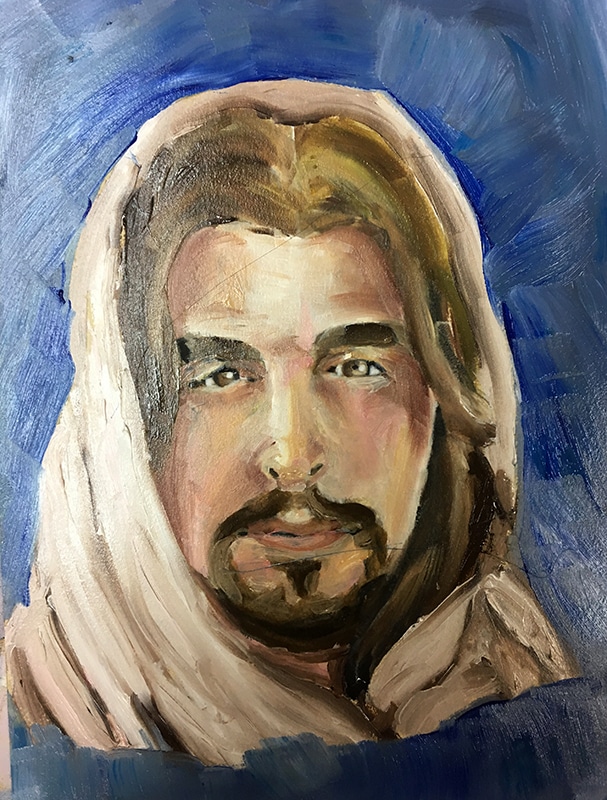ILL 207: Portrait Painting
Learn to capture the human form in a portrait
Portraiture has a rich history. In this online portrait painting course, you can learn time-honored techniques for portrait painting in oil. Working with an experienced painter, you'll utilize your knowledge of anatomy, learning how to construct a painting from drawing to underpainting to final work. Along the way you'll learn essentials for lights and darks, flesh tones, and laying on color. Helpful critiques on your drawings and paintings will help you improve your techniques and build your style.
About This Course
Project-Based Learning
Learn a classic, time-tested approach to portraiture as you take a project from initial drawing to underpainting to final portrait.
What Skills Will I Develop?
Students in this course can expect to learn to:
- Work with naturalistic and idealized depictions of the face, and with historical portraiture influences.
- Set up a portrait sitting including positioning and lighting of the subject.
- Use proportion, plumb line, and reference techniques to build portrait drawing skills.
- Create a cast drawing to demonstrate values and volume.
- Create an underpainting using specific value and volume representation techniques.
- Represent shadow and reflected light effectively in a portrait.
- Apply perceived color values and mix flesh tone paint effectively.
- Lay and handle paint appropriately for proper texture and value.
- Create attractive finished portraits that avoid common portraiture missteps.
What Software and Supplies Do I Need?
- Computer with a minimum internet connection speed of 512 kbps. Broadband is strongly recommended.
- A digital camera or smartphone with the ability to produce high-quality images to present your artwork.
- Oil or acrylic paints, canvas, brushes, and other art supplies are described in depth at the beginning of the class. Supplies may vary based on student needs and should be purchased after entering the class.
- Basic experience in painting and figure drawing.
Course Instructor(s)
The course is taught by the following instructor(s):

Jordon Schranz is an audio/visual artist and designer whose work has been exhibited internationally in New York, Chicago, El Paso, Berlin, Bogotá, and Ciudad Juárez.
Course Outline
Drawing for Portrait Painting
Drawing is the essential first step of portrait painting, capturing the subject's anatomy with accuracy. In the first lecture, you'll learn how to work with basic facial proportions and use important methods like plumb lines and reference points to represent the subject. You'll also learn about the types of portrait representation and the challenges of this art form.
Value and Underpainting
Before you can create a finished, full color portrait, you need to work with the values (lights and darks) of your subject and create an effective underpainting. This week's class looks at the procedures used in creating cast drawings and raw umber underpaintings, including methods for isolating and defining areas of similar values. You'll explore light theory, learning tips for representing light with paint in a portrait.
Laying on the Paint
The final step of an oil portrait is filling it with color, especially the flesh tones that take up so much of a portrait and are the most challenging to create. Local and perceived color choices are explored, including a look at the color combinations used by masters of portraiture, and you'll gain tips on mixing just the right flesh tones. You'll learn the best ways to lay your color onto your portrait and some important (and common) missteps to avoid.
Frequently Asked Questions (FAQ)
How Do The Courses Work?
Our courses are project-based and instructor-led. In each course you’ll complete a series of lectures, projects, discussions, and critiques designed to stretch your creative skills. Weekly assignment deadlines keep you on track, and with no set-logins or Zoom meetings, you can build your studies around your schedule.
Who Are The Instructors?
Our courses are developed and taught by our industry-leading faculty of creative professionals. This means that you’ll learn in-demand skills, get feedback on your work, and build a portfolio of creative work. View our Student Gallery for featured student projects.
When Can I Start?
Classes start January, April, and August, and this course can be completed as part of a 15-week term in 8 weeks. College credit from this course can be applied to a range of degree and certificate programs at Sessions College.
How Do I Register?
To register for a program, complete our program application. To register for this course on an individual basis, please contact our admissions team at admissions@sessions.edu. An Admissions Advisor will contact you to setup your enrollment.
| Course Tuition and Fees | |
|---|---|
| Tuition | $350/credit |
| Registration Fee* | $200 |
| Total Course Price | $725 |
Registration fees are nonrefundable after 5 days from enrollment.
Is Sessions College Accredited?
Yes. Since 2001, Sessions College has been accredited by the Distance Education Accrediting Commission (DEAC). The Distance Education Accrediting Commission is listed by the U.S. Department of Education as a recognized accrediting agency and is recognized by the Council for Higher Education Accreditation (CHEA).
RELATED PROGRAMS AT SESSIONS COLLEGE:


